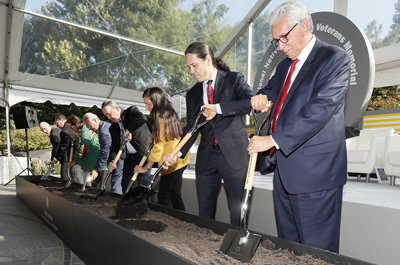WASHINGTON—The health of Native American veterans recently took center stage at congressional hearings—a rarity—as VA and the Indian Health Service prepare to update their memorandum of understanding on how the agencies share responsibility in caring for Native American veterans.

Last fall, Kevin Gover, director of the National Museum of the American Indian, right, accompanied by other dignitaries, broke ground for the National Native American Veterans Memorial on the National Mall. As VA and the Indian Health Service update their memorandum of understanding, the focus has been on the low health status of native veterans. Photo by Paul Morigi/AP Images for Smithsonian National Museum of the American Indian.
While American Indians and Alaska Natives serve in the U.S. armed forces at a higher rate per capita than any other ethnic group, they also have a lower health status than any other race or ethnic group. They have higher rates of infant mortality, diabetes, liver disease and suicide, as well as the highest rate of hepatitis C nationwide. From 1999 to 2015, AI/ANs saw a 519% increase in drug overdose deaths—the highest rate of increase of any demographic. These statistics highlight the challenges facing the two agencies as they attempt to plug the gaps that Native American veterans find themselves falling through.
The memo, first signed in 2003 and updated in 2010, established a resource-sharing agreement between VA and IHS and was designed to leverage the agencies’ strengths. For IHS and other tribal health programs, these strengths include an ability to reach patients where they live, as well as a cultural competency that allows them to better develop relationships with patients. For VA, the strength is in specialty care and in the sheer amount of resources for veterans. A December 2018 Government Accountability Office report found that IHS spending per user was $4,078, while VA’s was $10,692.
One common way for a Native American veteran to navigate this shared system of care is to get their basic, primary care from IHS and tribal health agencies, and go to VA for specialty care. Patients referred to VA from IHS frequently find themselves having to redo tests and procedures, however, which is a frustrating duplication of services that tribal leaders say contributes to veterans’ going elsewhere for their care. One of the reasons for that duplication of services is that health records cannot be electronically transferred between VA and IHS. Patients are still required to hand-carry their health records when moving between the two agencies.
“The way that VA has handled referrals from any of our partners outside VA is, frankly, untenable,” Kameron Matthews, MD, the VA deputy undersecretary for health told the VA House committee at a hearing in October. “The referral of a veteran back to VA for repeat visits or procedures is unnecessary. … We don’t want repetitive services.”
Matthews told legislators that, with the passing of the MISSION Act and the ability to streamline community care, she believes VA “has a real path forward” to solve that problem.
Areas of concern where the path forward is murkier include the ability of VA to reach Native veterans living in remote, rural areas. While VA’s first answer to access is telehealth, legislators and tribal leaders note that there are serious problems providing broadband in rural areas, especially on reservations, making telehealth difficult. While VA has a system where it can use telephone lines rather than broadband to implement telehealth, VA leaders admit that is not adequate.
Testifying before the Senate Indian Affairs Committee last month, VHA Chief Richard Stone, MD, said that one solution is continuing to partner with private companies to provide venues for care. In October, VA, in partnership with the healthcare technology company Philips, opened a telehealth mobile unit at a VFW post in Eureka, MT. Veterans using the unit will have virtual appointments with VA clinicians.
“This is literally a remote clinic that we provide the infrastructure for,” Stone explained. “We will be expanding these dramatically, we hope, in the near future. … Veterans can be so geographically dispersed that even our mobile units are not enough. That’s why we think these kind of partnerships with the VFW and Philips is [a model] we must go to.”
VA also has developed a similar partnership with Walmart to establish telehealth clinics in those stores.
Continue Reading this Article: High Suicide Rate

